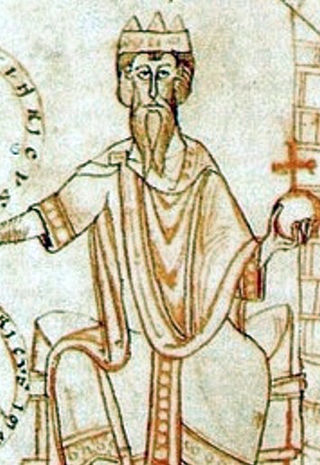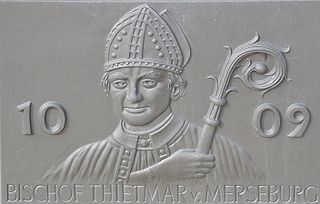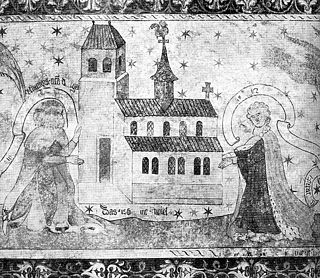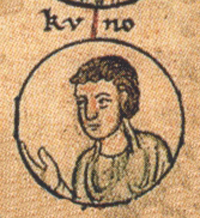Related Research Articles

Conrad II, also known as Conrad the Elder and Conrad the Salic, was the emperor of the Holy Roman Empire from 1027 until his death in 1039. The first of a succession of four Salian emperors, who reigned for one century until 1125, Conrad ruled the kingdoms of Germany, Italy and Burgundy.

Henry II, called the Wrangler or the Quarrelsome, a member of the German royal Ottonian dynasty, was Duke of Bavaria from 955 to 976 and again from 985 to 995, as well as Duke of Carinthia from 989 to 995.
Rudolph III, called the Idle or the Pious, was the king of Burgundy from 993 until his death. He was the last ruler of an independent Kingdom of Burgundy, and the last male member of the Burgundian group of the Elder House of Welf.

Thietmar, Prince-Bishop of Merseburg from 1009 until his death, was an important chronicler recording the reigns of German kings and Holy Roman Emperors of the Ottonian (Saxon) dynasty. Two of Thietmar's great-grandfathers, both referred to as Liuthar, were the Saxon nobles Lothar II, Count of Stade, and Lothar I, Count of Walbeck. They were both killed fighting the Slavs at the Battle of Lenzen.
Herman II was a member of the Conradine dynasty. He was Duke of Swabia from 997 to his death. In 1002, Herman unsuccessfully attempted to become king of Germany.

Burchard III, a member of the Hunfriding dynasty, was the count of Thurgau and Zürichgau, perhaps of Rhaetia, and then Duke of Swabia from 954 to his death.

Conrad I, a member of the Salian dynasty, was Duke of Carinthia from 1004 until his death.
Henry of Schweinfurt was the Margrave of the Nordgau from 994 until 1004. He was called the "glory of eastern Franconia" by his own cousin, the chronicler Thietmar of Merseburg.

Eckard I was Margrave of Meissen from 985 until his death. He was the first margrave of the Ekkehardinger family that ruled over Meissen until the extinction of the line in 1046.
Dietrichof Haldensleben was a count in the Schwabengau, later also in the Nordthüringgau and the Derlingau, who was the first Margrave of the Northern March from 965 until the Great Slav Rising of 983. He also bore the title of a dux (duke) in contemporary sources.
Lothair I was Margrave of the Nordmark from about 983 until his death. He was also a member of Saxon nobility as Count of Derlingau and of Nordthüringgau.
Gunther was the Margrave of Merseburg from 965 until his death, upon which the march of Merseburg was united to that of Meissen.

Otto I, traditionally known as Otto the Great, was East Frankish king from 936 and Holy Roman Emperor from 962 until his death in 973. He was the eldest son of Henry the Fowler and Matilda of Ringelheim.

Henry II, also known as Saint Henry the Exuberant, Obl. S. B., was Holy Roman Emperor from 1014. He died without an heir in 1024, and was the last ruler of the Ottonian line. As Duke of Bavaria, appointed in 995, Henry became King of the Romans following the sudden death of his second cousin, Emperor Otto III in 1002, was made King of Italy in 1004, and crowned emperor by Pope Benedict VIII in 1014.

The German–Polish War consisted of a series of struggles in 1003–1018, between the Ottonian king Henry II of Germany and the Polish Piast ruler Bolesław I the Brave. The locus of conflict was the control of Lusatia, Upper Lusatia, as well as Bohemia, Moravia and Slovakia. The fighting ended with the Peace of Bautzen in 1018, which left Lusatia and Upper Lusatia as a fief of Poland, and Bohemia became a duchy in the Holy Roman Empire.
Lothar II (874-929), Count of Stade, son of Lothar I, Count of Stade, and Oda of Saxony, daughter of Liudolf, Duke of Saxony. Lothar was the great-grandfather of Thietmar of Merseburg, and is frequently confused in genealogical sources with Thietmar’s other great-grandfather of the same name who was Count of Walbeck.
Henry I the Bald was Count of Stade. He was son of Lothar II, Count of Stade, and Swanhild of Saxony. Henry is recorded as a cousin of Otto I, Holy Roman Emperor, but their exact relationship remains a mystery. Henry was also appointed Count of Heilangau, the ancient capital of Stade, in 959.
Lothair Udo I, Count of Stade, son of Henry I the Bald, Count of Stade, and his wife Judith von der Wetterau, granddaughter of Gebhard, Duke of Lorraine. Lothair is frequently confused with his nephew Lothair Udo II, son of his brother Siegfried II, who was Margrave of Nordmark as Lothair Udo I.
Siegfried II, Count of Stade, was the youngest son of Henry I the Bald, Count of Stade, and his wife Judith von der Wetterau, granddaughter of Gebhard, Duke of Lorraine. He succeeded his brother, Henry as Count of Slade in 1016.
Siegfried I the Elder, Count of Walbeck and Möckerngau, son of Lothar II the Old, Count of Walbeck, and Mathilde von Arneburg.
References
- ↑ Reuter 2006, p. 696.
- 1 2 Thietmar von Merseburg 2001, p. 92-93.